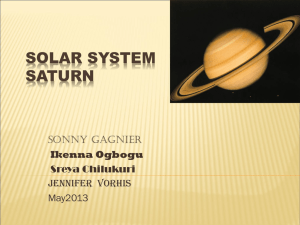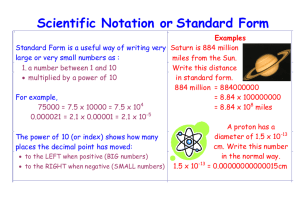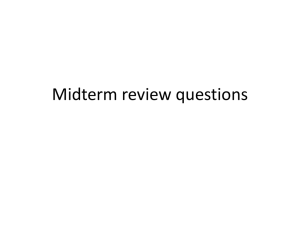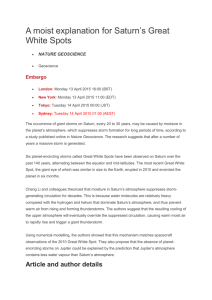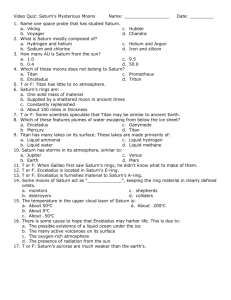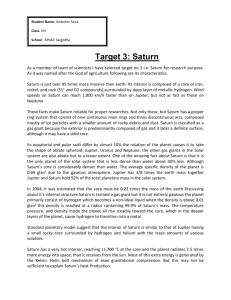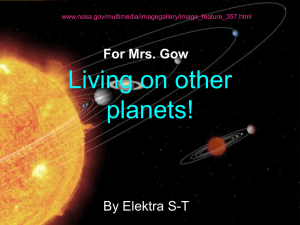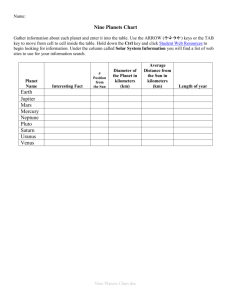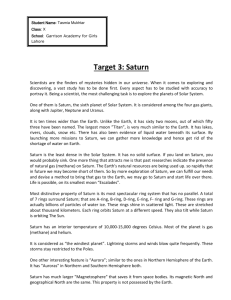Survey of Saturn! - Winchester Science Centre
advertisement
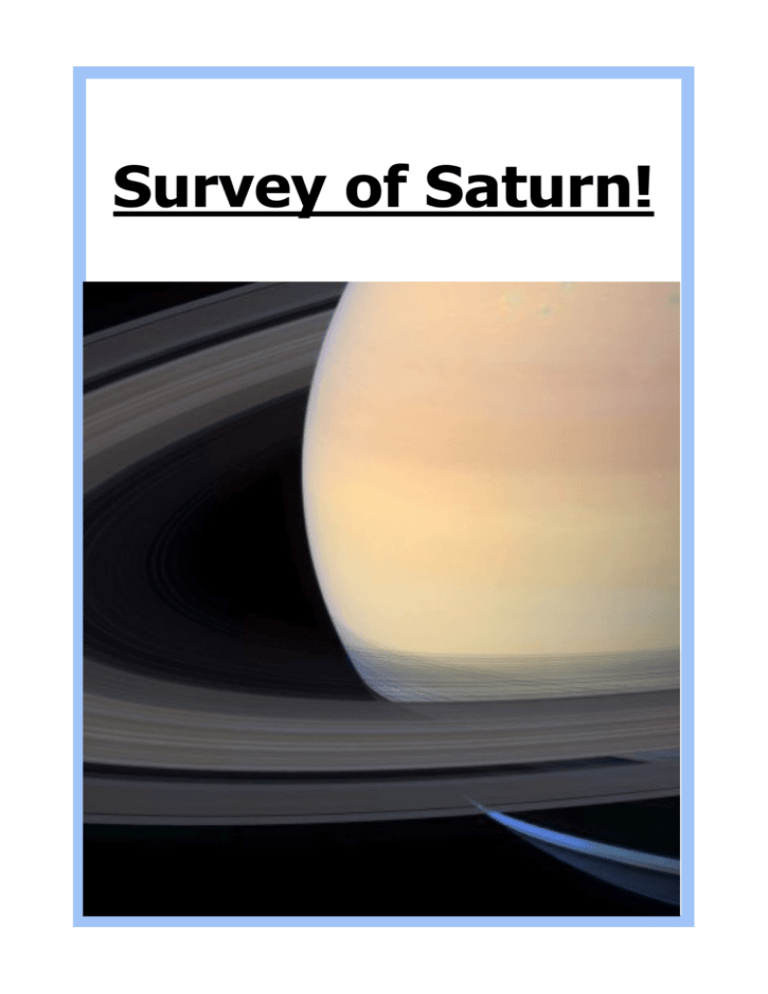
Survey of Saturn! Teacher’s Sheet Survey of Saturn: Activity for upper KS2 As a class or in groups, pupils read the ‘Fact or Fiction’ cards. On each card there are three statements. Two are false and one of the statements is true. The pupils have to try and work out which are true and which are false. Other Resources: The website http://starchild.gsfc.nasa.gov/ is very easy to use and can be useful for students to conducting their own research. This ‘space school’ video provides a useful introduction to Saturn: http://www.youtube.com/watch? v=MS9D9CzwPQU The National School’s Observatory http:// www.schoolsobservatory.org.uk/ also is easy to use and students can find their own data on it. Teacher’s Sheet Survey of Saturn: Activity for upper KS2 Fact or Fiction: Question 1: 3. Just to check that the pupils understand how the questions work, and how important it is to read the question thoroughly. Question 2: 1. Planets and space bodies are usually named by the International Astronomical Union (IAU) but the close planets can be seen without a telescope and so were first named by the Romans. Neptune and Uranus were discovered more recently, but the IAU decided to continue calling them after Roman (and Greek) gods. Other planets: Mercury is the god of commerce, travel and thievery in Roman mythology. The planet probably received this name because it moves so quickly across the sky. Venus is the Roman goddess of love and beauty. The planet is aptly named since it makes a beautiful sight in the sky, with only the Sun and the Moon being brighter. Earth is the only planet whose English name does not derive from Greek/Roman mythology. The name derives from Old English and Germanic. There are, of course, many other names for our planet in other languages. Mars is the Roman god of War. The planet probably got this name due to its red color. Jupiter was the King of the Gods in Roman mythology, making the name a good choice for what is by far the largest planet in our solar system. Saturn is the Roman god of agriculture. Saturday is ‘Saturn’s Day’. Uranus is the ancient Greek deity of the Heavens, the earliest supreme god. Question 3: 2. The gravity on Saturn is 0.91 x gravity on Earth. This is because although Saturn is a lot bigger than the Earth, it is not very dense. Question 4: 2. Saturn is further from the Sun than the Earth, so less sunlight reaches it. It does have a very very hot core though. Question 5: 2. Saturn is a ball made up almost entirely of hydrogen and helium. The density and temperature changes the deeper into the planet you go, but Saturn can't be said to have a solid surface. If you tried to walk on the surface of Saturn you would fall into the planet, suffering higher temperatures and pressures until you were crushed inside the planet. Teacher’s Sheet Question 6: 3. The fascinating ring system observed by Galileo in 1610 is only beginning to be understood. At first thought to be a solid ring it is now known to be thousands of water ice particles with some chunks as big as a small car. Question 7: 3. Saturn is made out of gas so there would be nothing for the astronauts to step on! A few un-manned spacecraft have gone near Saturn to take pictures, but they are mostly interested in Saturn’s moons which could contain water. Question 8: 2. Its diameter is about 120,536 km at the equator. From pole to pole to pole it is 108,728 km. That’s about 9.4 times that of Earth. The volume of Saturn is 8.2713 x 10 (x14). It means you can fit in 764 Earth sized planets in Saturn comfortably. The surface area is 4.27 x 1010 sq km. This is 84 times that of the Earth. Question 9: 1. Saturn has at least 62 moons but we seem to be discovering more all of the time! Some of the moons around Saturn are more interesting to scientists than Saturn itself because they contain ice and water, so could contain extra-terrestrial life. Question 10: 3. Saturn is a gas giant, it is not very dense at all and is less dense than water. It would float if you could find a pond big enough! Q.1 Fact or Fiction? Only one of these statements is true. Which is it? 1. Saturn is the fifth planet from the sun. 2. Saturn is closer to the sun than Earth. 3. Saturn is the sixth planet from the sun. Q.2 Fact or Fiction? Only one of these statements is true. Which is it? 1. Saturn is named after the Roman god of agriculture. 2. Saturn is named after the Greek god of agriculture. 3. Saturn is named after Saturday, because it was found on a Saturday. Q.3 Fact or Fiction? Only one of these statements is true. Which is it? 1. The gravity on Saturn is much less than on Earth (you feel lighter). 2. The gravity on Saturn is very similar to Earth. 3. The gravity on Saturn is much more than on Earth (you feel heavier). Q.4 Fact or Fiction? Only one of these statements is true. Which is it? 1. Saturn is very cold, the temperature is around – 20°C. 2. Saturn is very cold, the temperature is around –175°C . 3. Saturn is very hot, the temperature is around 80°C . Q.5 Fact or Fiction? Only one of these statements is true. Which is it? 1. Saturn is rocky like Earth. 2. Saturn is mostly gas so you can’t stand on it. 3. Saturn is covered in a giant ocean. Q.6 Fact or Fiction? Only one of these statements is true. Which is it? 1. Saturn has rings made out of spaghetti. 2. Saturn has rings made out of lots of bits of rock. 3. Saturn has rings made out of lots of bits of ice. Q.7 Fact or Fiction? Only one of these statements is true. Which is it? 1. Only 2 astronauts have ever stepped on Saturn. 2. Only 1 astronaut has ever stepped on Saturn. 3. No astronauts have ever been to Saturn. Q.8 Fact or Fiction? Only one of these statements is true. Which is it? 1. Saturn is a similar size to the Earth. 2. Saturn is much bigger than the Earth. 3. Saturn is much smaller than the Earth. Q.9 Fact or Fiction? Only one of these statements is true. Which is it? 1. Saturn has 62 moons. 2. Saturn has 21 moons. 3. Saturn has 1 moon. Q.10 Fact or Fiction? Only one of these statements is true. Which is it? 1. Saturn is really big and also really heavy. 2. Saturn is really small but really heavy. 3. Saturn is really big but also really light, it would float on water! Images of Saturn:
